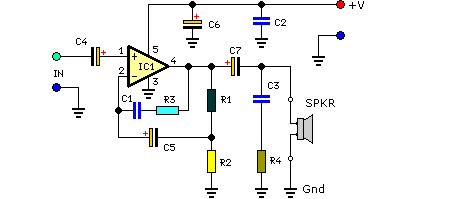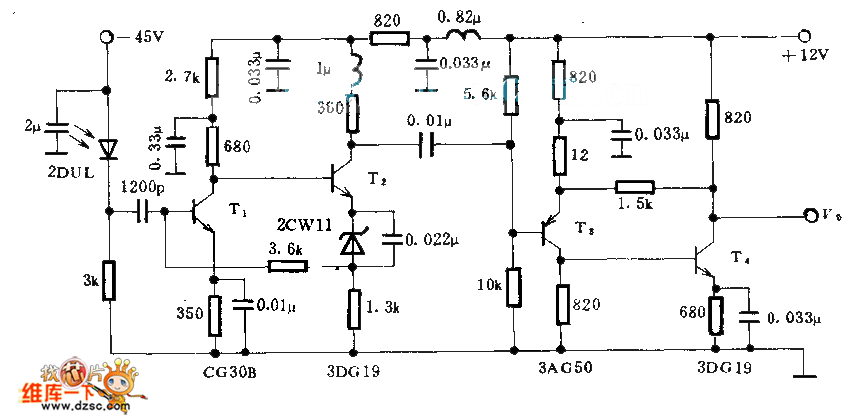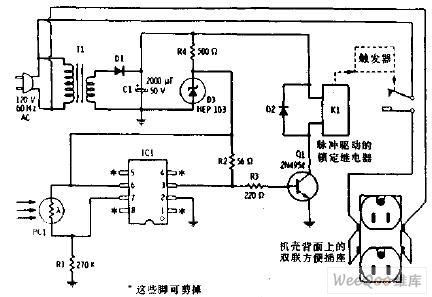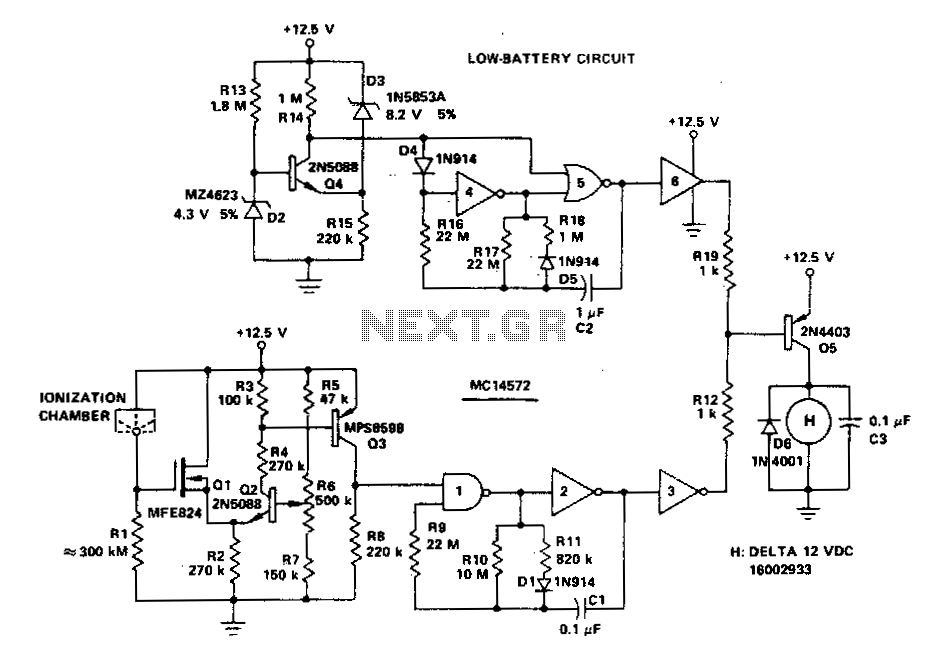
Bandwidth broadband linear detector circuit schematic of 10MHz
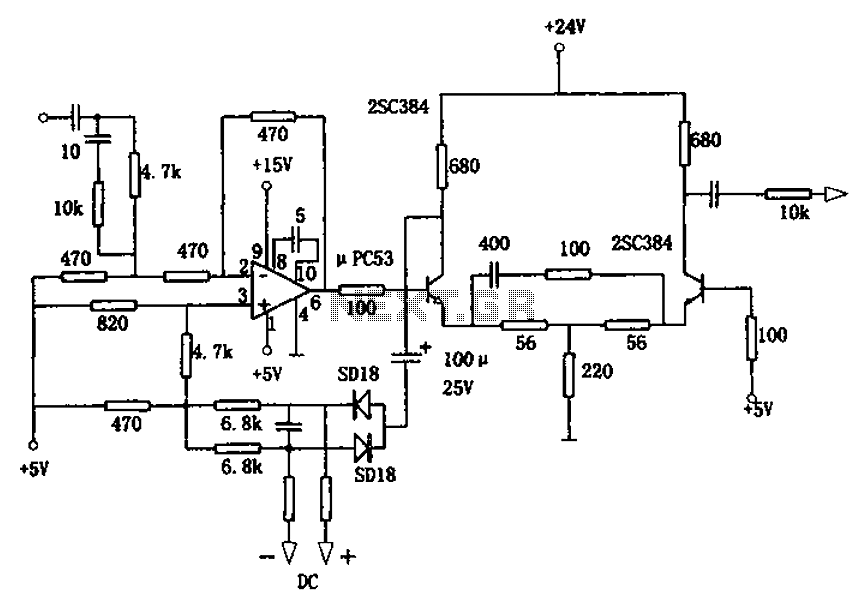
The circuit is designed for a broadband linear detection application with a bandwidth of 10 MHz. It serves as a millivoltmeter measuring instrument suitable for frequencies exceeding 10 MHz. The circuit features a linear detector utilizing operational amplifiers, specifically the wideband PC53. The output is generated by a differential amplifier constructed from 2SC384 transistors. Additionally, the circuit employs germanium diodes for detection and is connected to a negative feedback loop to enhance the performance of the differential circuit, thereby improving the power supply voltage.
The broadband linear detection circuit is structured to effectively measure small voltage signals in the millivolt range at frequencies beyond 10 MHz. The core of the circuit utilizes operational amplifiers, known for their high gain and bandwidth capabilities, which allows for the accurate amplification of the input signal. The choice of the PC53 operational amplifier is critical due to its wide bandwidth characteristics, making it suitable for high-frequency applications.
The differential amplifier stage, implemented using 2SC384 transistors, serves to further amplify the signal while maintaining linearity. This stage is vital for ensuring that the output signal remains proportional to the input, which is essential for accurate measurements. The use of transistors in the differential amplifier configuration not only enhances the gain but also improves the circuit's noise performance, making it more suitable for low-level signal detection.
Incorporating germanium diodes in the detection process is a strategic choice, as these diodes exhibit low forward voltage drop and fast response times, which are advantageous for high-frequency signal detection. The diodes are integrated into the circuit to convert the amplified AC signal into a DC voltage that can be easily measured.
The negative feedback mechanism is implemented to stabilize the operation of the differential amplifier, which helps in minimizing distortion and improving the linearity of the output signal. This feedback loop is essential for maintaining consistent performance across varying input signal levels, thereby enhancing the reliability of the measurement instrument.
Overall, this broadband linear detection circuit is a sophisticated design that combines operational amplifiers, transistors, and germanium diodes to create an effective millivoltmeter capable of measuring high-frequency signals with precision and accuracy. As shown for the bandwidth of 10MHz broadband linear detection circuit. The circuit is the bandwidth Millivoltmeter measuring instruments, such as used above 10MHz of broadband linear detector circuit. Operational Amplifiers using wideband PC53, output by the differential amplifier formed by transistors 2SC384 amplified. Circuit germanium diode detector diodes do, and connected to the negative feedback circuit, the differential circuit to improve the power supply voltage.
The broadband linear detection circuit is structured to effectively measure small voltage signals in the millivolt range at frequencies beyond 10 MHz. The core of the circuit utilizes operational amplifiers, known for their high gain and bandwidth capabilities, which allows for the accurate amplification of the input signal. The choice of the PC53 operational amplifier is critical due to its wide bandwidth characteristics, making it suitable for high-frequency applications.
The differential amplifier stage, implemented using 2SC384 transistors, serves to further amplify the signal while maintaining linearity. This stage is vital for ensuring that the output signal remains proportional to the input, which is essential for accurate measurements. The use of transistors in the differential amplifier configuration not only enhances the gain but also improves the circuit's noise performance, making it more suitable for low-level signal detection.
Incorporating germanium diodes in the detection process is a strategic choice, as these diodes exhibit low forward voltage drop and fast response times, which are advantageous for high-frequency signal detection. The diodes are integrated into the circuit to convert the amplified AC signal into a DC voltage that can be easily measured.
The negative feedback mechanism is implemented to stabilize the operation of the differential amplifier, which helps in minimizing distortion and improving the linearity of the output signal. This feedback loop is essential for maintaining consistent performance across varying input signal levels, thereby enhancing the reliability of the measurement instrument.
Overall, this broadband linear detection circuit is a sophisticated design that combines operational amplifiers, transistors, and germanium diodes to create an effective millivoltmeter capable of measuring high-frequency signals with precision and accuracy. As shown for the bandwidth of 10MHz broadband linear detection circuit. The circuit is the bandwidth Millivoltmeter measuring instruments, such as used above 10MHz of broadband linear detector circuit. Operational Amplifiers using wideband PC53, output by the differential amplifier formed by transistors 2SC384 amplified. Circuit germanium diode detector diodes do, and connected to the negative feedback circuit, the differential circuit to improve the power supply voltage.
Warning: include(partials/cookie-banner.php): Failed to open stream: Permission denied in /var/www/html/nextgr/view-circuit.php on line 713
Warning: include(): Failed opening 'partials/cookie-banner.php' for inclusion (include_path='.:/usr/share/php') in /var/www/html/nextgr/view-circuit.php on line 713
